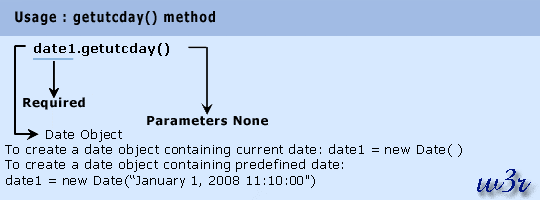JavaScript getUTCday() Method: Date Object
Description
The getUTCday() method returns the day of the week in the specified date according to universal time(UTC). The value returned by getUTCDay() is an integer between 0 and 6 corresponding to the day of the week as follows.
| Value | Day of the week |
|---|---|
| 0 | Sunday |
| 1 | Monday |
| 2 | Tuesday |
| 3 | Wednesday |
| 4 | Thursday |
| 5 | Friday |
| 6 | Saturday |
Version
Implemented in JavaScript 1.3
Syntax
getUTCDay()

Example:
The following web document getUTCDay() method returns the day of the week of a given date and current date according to universal time.
<!DOCTYPE html PUBLIC "-//W3C//DTD XHTML 1.0 Transitional//EN"
"http://www.w3.org/TR/xhtml1/DTD/xhtml1-transitional.dtd">
<html xmlns="http://www.w3.org/1999/xhtml" xml:lang="en" lang="en">
<head>
<meta http-equiv="content-type" content="text/html; charset=iso-8859-1" />
<title>JavaScript date object - getUTCDay() method example</title>
</head>
<body>
<h1 style="color: red">JavaScript date object : getUTCDay() method</h1>
<hr />
<script type="text/javascript">
//This is done to make the following JavaScript code compatible to XHTML. <![CDATA[
newyear2008 = new Date("January 1, 2008 11:10:00")
day = newyear2008.getUTCDay()
document.write("The day of the week of "+newyear2008+" is : "+day+"<br />")
current_date = new Date()
cday = current_date.getUTCDay()
document.write("The day of the week of current date is : "+cday)
//]]>
</script>
</body>
</html>
View the example in the browser
Supported Browser
| Internet Explorer 7 | Firefox 3.6 | Google Chrome 7 | Safari 5.0.1 | Opera 10 |
| Yes | Yes | Yes | Yes | Yes |
See also:
JavaScript Core objects, methods, properties.
Previous: JavaScript getUTCdate() Method: Date Object
Next: JavaScript getUTCfullyear() Method: Date Object
Test your Programming skills with w3resource's quiz.
